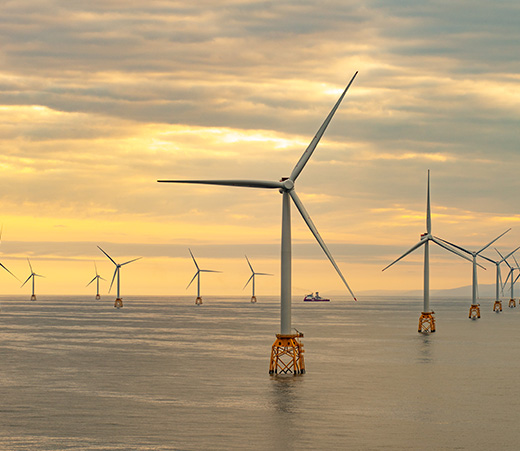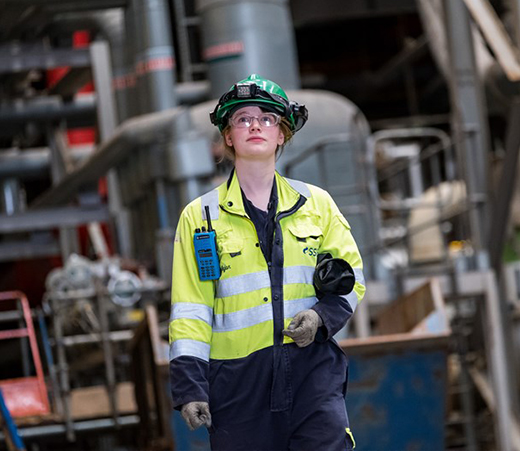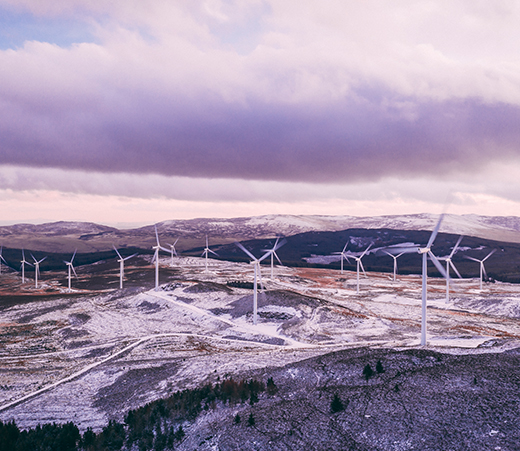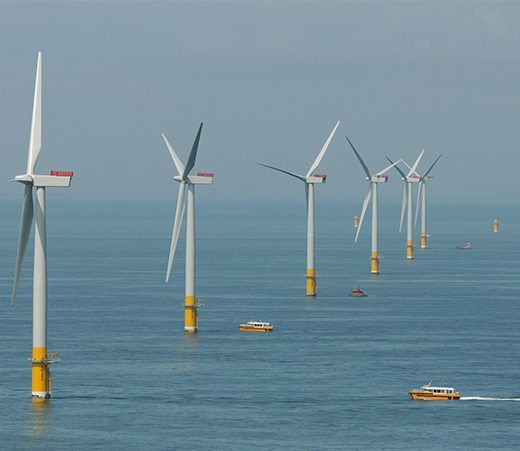The need to reach net zero emissions by 2050 is driving a transformation of the GB energy system. The UK was the first major economy to commit to net zero emissions by 2050, and the UK government has also set into law the Climate Change Committee’s (CCC) recommendation to reduce emissions in 2035 by 78% compared to 1990 levels in the sixth Carbon Budget.
There are multiple possible pathways to achieving these ambitious targets through the deployment of different technologies and the markets, policy and regulation to deploy them cost effectively. So how do you build a low carbon energy system without breaking the bank?
We’ve worked with energy modelling experts LCP to assess the most efficient ways to decarbonise whilst keeping costs down and the lights on. They identified five steps to cut the cost of decarbonise electricity in Great Britain – and do so quicker too.

The UK power sector has delivered significant emissions reductions in the last decade, reducing its emissions by 68% since 2010.
At SSE we are extremely proud to have played our part in that, drastically reducing our own emissions while delivering major investment in the country’s low-carbon infrastructure.
In the run-up to COP26, the UK can showcase its leadership on power sector decarbonisation, demonstrating how renewable energy can be deployed at scale and at pace, and blazing a trail on that the transition away from coal that is so urgently needed if we are to keep global average temperature changes to within 1.5oC of pre-industrial levels.
Whilst the UK’s large-scale deployment of renewable energy and switching away from coal, driven by effective long-term policy mechanisms and robust carbon pricing, has proved extremely successful in driving rapid emissions reduction in the GB electricity system, the last 10-30% of emissions will be more difficult to tackle. We will need to bring forward a range of new technologies, products and services to ensure we have reliable low-carbon energy when the sun is not shining and the wind is not blowing.
Electricity is an essential service and we’ve seen in the past that keeping a grip on its affordability is critical if a public mandate for decarbonisation is to be maintained.
As the ‘low-hanging fruit’ disappears and decarbonisation becomes more challenging, it is therefore vital that we find the most cost-effective pathway to net zero to minimise the cost to consumers.
We have commissioned this analysis from LCP in order to do exactly that. We hope it will help inform the next stage of the UK’s journey to net zero emissions, by identifying clear actions that could drastically cut the cost of net zero electricity – which will be invaluable in helping to decarbonise the wider economy.
As this analysis outlines, net zero power needn’t break the bank, and with the five steps outlined the GB power system could save almost £50bn by 2050, and over £75bn looking out to 2060.
It shows that there is a clear path for the UK to take: offshore wind will be at the centre of the GB energy system, supported by progressively decarbonised gas-fired generation in the form of carbon capture and storage (CCS) and hydrogen. Onshore wind and solar, too, have important
roles to play, as does consumer flexibility alongside batteries, hydro pumped storage and hydrogen storage to ensure we can maximise the use of the UK’s significant renewable energy potential. The role of large-scale new nuclear in an affordable net zero transition, however, is less clear.
To deliver on this vision we need to ensure that the right policy and regulatory frameworks are in place and provide effective signals to support early, strategic deployment of enabling energy infrastructure. Critically, a net zero power system requires a net zero electricity market design, and this report shows this is where the greatest savings are to be had, with a £20bn cost reduction by 2050 compared with maintaining current arrangements.
Over the 2020s, the electricity sector can lead a green recovery that generates socio-economic benefits spread across the UK and provides the means by which to decarbonise the wider economy. As this report clearly shows, if we plot the right pathway to net zero it will not only deliver benefits today in the form of green jobs, clean industries and revitalised communities, but safeguard the interests of future consumers who will have to pay for the decisions we make today and will ultimately be faced with the greatest impacts of climate change if we fail to achieve net zero quickly enough.
I sincerely hope that this analysis proves useful to policymakers and other stakeholders as we collectively seek to address the climate crisis.
Alistair Phillips-Davies, CEO of SSE
"Our analysis shows that by harnessing renewable energy and new technologies, the UK can deliver net zero quicker and cheaper than previously expected. To achieve this route to a cleaner and greener future, policy and regulation will need to give a clear signal on the UK’s decarbonisation trajectory. This will attract the investment needed to build the Net Zero infrastructure required to make sure the UK fully addresses the climate crises.”
Tom Porter, Strategy Director at LCP
Five steps to low cost, low carbon
- Go big on offshore wind = £7.3bn saving
- Flexible low carbon thermal generation to support a renewables-led energy system = £7.5bn saving
- Deploy long duration storage and green hydrogen = £4.9bn saving
- Market reform to value all low carbon equally = £19.7bn saving
- A coordinated approach to offshore transmission = £8.8bn saving
£48bn total savings by 2050
*System cost savings between 2021-2050.
(and £76bn if looking out to 2060)
7.5m tonnes of CO2 saved by 2035 and 20m tonnes by 2050
Step by step
An energy system based on renewable energy supported by decarbonised gas generation storage can deliver carbon savings faster and with the support of long duration storage, market reform and regulatory change can achieve system cost savings of over £48bn between now and 2050, relative to current plans, with a further £28bn of benefits accrued through to 2060.

1. Go big on offshore wind.
The UK and Ireland have an incredible offshore wind potential with an abundance of clean, green renewable energy on our doorstep – and offshore wind will be at the heart of a decarbonised energy system. The first step to our low cost, high renewable system analysis was an increase in offshore wind generation. The UK is currently targeting 40GW of offshore wind by 2030, but there is less certainty out to 2050 with the CCC suggesting up 140GW. The analysis showed that increasing GB ambition on offshore wind in 2050 from 73GW to 97GW resulted in a £7.3bn system cost saving over the 2021-2050 period, largely from displacing 5GW of nuclear generation that would require additional consumer subsidy into the 2060s. With greater cost reductions and developments in floating wind, the 2050 ambition could be higher and cost savings greater.

2. Increasing flexible low carbon thermal generation.
The second step sees an increase in decarbonised gas generation to provide the flexible and firm capacity to support increased renewables. The analysis suggests that an additional 5GW of Gas CCS would displace another [5GW] of nuclear capacity resulting in a £7.5bn system cost saving over the 2021-2050 period. Power CCS and hydrogen power generation would complement a renewables-led energy system, helping to fill extended periods when the sun doesn’t shine or wind doesn’t blow. Whilst CCS and hydrogen technology will be critical for a net zero power system, importantly this would support the deployment of CO2 and hydrogen infrastructure in the UK’s industrial heartlands, decarbonising industry, supporting green jobs and revitalising communities.

3. Deploying long duration storage.
Whilst dispatchable low carbon thermal generation will be needed to meet extended periods without renewables, being able to flex demand and store energy will maximise renewable output and reduce wastage. The third step is an increase in long duration storage and hydrogen electrolysis or ‘green hydrogen’. The analysis includes an additional 5GW of hydro pumped storage and 15GW of hydrogen electrolysers with early-deployment of hydrogen storage in salt caverns. This results in a £4.9bn system cost saving over 2021-2050 period. Whilst the analysis highlights the significant system benefit from long duration storage, support mechanisms will be need to ensure the strategic deployment of long life, geographically limited assets like hydro pumped storage and hydrogen storage, alongside the development of hydrogen electrolysers to help drive down costs, support a UK supply chain and integrate renewable energy onto the system.

4. Value all low carbon generation equally
The CfD has been extremely successful in deployment of large volumes of renewable energy and driving down costs, most notably in offshore wind. The fourth step looks for electricity market reforms to value all low carbon generation equally – whether its new or existing. Under this scenario existing low-carbon capacity can access revenue stabilisation to cover their fixed costs to support life extensions or incentivise refurbishments and repowering. Utilising existing capacity more efficiently by reforming the electricity market to incentivise a cost effective mix of existing assets over more expensive new build would result in a £19.7bn system cost saving over the 2021-2050 period. A net zero electricity market dominated by low or zero marginal costs generation like wind and solar require a net zero electricity market design.

5. A coordinated approach to offshore grids.
Connecting 40GW of offshore wind by 2030 will require greater coordination to minimise cost and reduce disruption to communities and the environment. In addition, not only could electricity transmission constrain the UK’s 2030 ambitions, it could act as a limiting factor in developing our offshore wind resource out to 2050. The fifth and final step would implement a more coordinated offshore network to ensure the efficient connection of new offshore wind hubs. This would allow offshore transmission assets to be shared between multiple offshore wind projects resulting in an £8.8bn system cost saving over the 2021-50 period, alongside the reduced local impacts. Offshore grids are an area where more can be done to develop an important UK industry, by deploying innovative new approaches and technologies like those being looked at to connect offshore wind elsewhere in Europe.
Net zero power without breaking the bank: The webinar
A cost-effective road map
We don’t have time – or money – to waste and with an abundance of clean, green renewable energy on our doorstep and new technologies emerging as cost-effective front runners, the UK should focus its efforts on lower cost routes to reach net zero.
Our low-cost, high-renewable scenario starts with the current trajectory to net zero, and re-centres it around the UK’s strategic advantages:
- greater use of our abundant wind resource around our coast and world-leading offshore wind industry;
- repurposing our oil & gas expertise into new CCS and hydrogen technologies to revitalise our industrial heartlands;
- using our unique geography to store energy as water in the mountains of Scotland and hydrogen in the salt caverns of northern England; and
- developing our offshore electricity transmission expertise with new HVDC technologies to develop integrated offshore grids.
Focusing on where the UK is strongest will not only benefit UK plc, but will benefit consumers and the wider environment, and support the charge on technologies need internally to decarbonise and tackle the climate crisis.
We already knew that we needed to go further and faster so more ambition is required; that’s why this report is so important. We need to reassess the tools we need to get there and how we do it at best value for consumers and society.
The analysis from LCP offers a cost-effective road-map to deliver that change.


